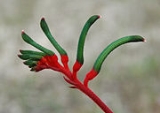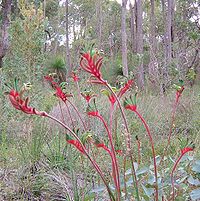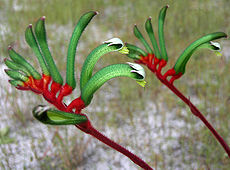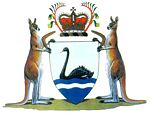
Anigozanthos manglesii
Encyclopedia
Anigozanthos manglesii, commonly known as the Red and Green Kangaroo Paw or Mangles Kangaroo Paw, is a plant species endemic
to Western Australia
, and the floral emblem
of that state.
The most admired of the Kangaroo paw
species, the flower has become symbolic of the region. The display between August and November is remarkable for the high standing flowers, occurring in urban and coastal regions. The species is not threatened, but is protected under state legislation. A license is required for their collection. It is desirable as a cut flower, possessing an unusual form and striking colours that last well.
perennial
which has long, grey-green linear leaves around 30 to 60 cm long. A member of the Anigozanthos
genus, it is less than a shrub in its form. The leaves are grey-green and extend from a central point at ground level, giving the form of its base. Its red and green flowers appear at the end of long stalks between August and November. The flowers display in a sequence from the lowest point, those following are in a progression of development. The spent flower-stalks may remain well after their season. The length of these stalks from the base is up to 1200 mm tall.


 The species is widely distributed throughout the Southwest Australia
The species is widely distributed throughout the Southwest Australia
n biogeographic regions, preferring white, yellow or grey sand, or sandy loam. The occurrence is confirmed in the northern most part of its range in the Geraldton Sandplains
and the Swan Coastal Plain
near Perth
. Extensive records also exist of occurrence in Jarrah Forest
and Warren region to the south, but not reaching the southern coasts. It extends inland to the Avon Wheatbelt
.
in 1834 from the type specimen:
There are two recognised subspecies as follows:
Anigozanthos manglesii is known to hybridize naturally with other Anigozanthos species:
and to a lesser extent A. rufus. Cultivars include:
. They are dormant in the summer, and watering should be withheld during this period. They are susceptible to the fungal ink spot disease and the leaves are attractive to snails. They are often used as cut flowers, due to their unique appearance and lasting qualities.

In November 1960, Anigozanthos manglesii was adopted as the floral emblem
of Western Australia in a proclamation made by then Premier of Western Australia David Brand
.
It also appears on the armorial bearings of that state, framing the crown in the Coat of arms
. This is given to denote the sovereignty and independence of Western Australia. The blazon
reads:
A Red and Green Kangaroo Paw superimposed over a scene of Perth
was depicted on a 5 pence on a 1962 Australian stamp issue designed by R. M. Warner to mark the British Empire and Commonwealth Games
held in Perth that year. In 1968 another stamp issue, designed by Nell Wilson, showed the Red and green Kangaroo Paw as part of a series on state floral emblems.
Endemic (ecology)
Endemism is the ecological state of being unique to a defined geographic location, such as an island, nation or other defined zone, or habitat type; organisms that are indigenous to a place are not endemic to it if they are also found elsewhere. For example, all species of lemur are endemic to the...
to Western Australia
Western Australia
Western Australia is a state of Australia, occupying the entire western third of the Australian continent. It is bounded by the Indian Ocean to the north and west, the Great Australian Bight and Indian Ocean to the south, the Northern Territory to the north-east and South Australia to the south-east...
, and the floral emblem
Floral emblem
In a number of countries, plants have been chosen as symbols to represent specific geographic areas. Some countries have a country-wide floral emblem; others in addition have symbols representing subdivisions. Different processes have been used to adopt these symbols - some are conferred by...
of that state.
The most admired of the Kangaroo paw
Kangaroo paw
Kangaroo paw is a common name for a number of species, in two genera of the family Haemodoraceae, that are endemic to the south-west of Western Australia. These perennial plants are noted for their unique bird attracting flowers...
species, the flower has become symbolic of the region. The display between August and November is remarkable for the high standing flowers, occurring in urban and coastal regions. The species is not threatened, but is protected under state legislation. A license is required for their collection. It is desirable as a cut flower, possessing an unusual form and striking colours that last well.
Description
Anigozanthos manglesii is a rhizotomousRhizome
In botany and dendrology, a rhizome is a characteristically horizontal stem of a plant that is usually found underground, often sending out roots and shoots from its nodes...
perennial
Perennial plant
A perennial plant or simply perennial is a plant that lives for more than two years. The term is often used to differentiate a plant from shorter lived annuals and biennials. The term is sometimes misused by commercial gardeners or horticulturalists to describe only herbaceous perennials...
which has long, grey-green linear leaves around 30 to 60 cm long. A member of the Anigozanthos
Anigozanthos
Anigozanthos is a small genus of Australian plants in the Bloodwort family Haemodoraceae. The 11 species and several subspecies are commonly known as kangaroo paw and catspaw depending on the shape of their flowers...
genus, it is less than a shrub in its form. The leaves are grey-green and extend from a central point at ground level, giving the form of its base. Its red and green flowers appear at the end of long stalks between August and November. The flowers display in a sequence from the lowest point, those following are in a progression of development. The spent flower-stalks may remain well after their season. The length of these stalks from the base is up to 1200 mm tall.
Distribution



Southwest Australia
Southwest Australia is a biodiversity hotspot that includes the Mediterranean forests, woodlands, and scrub ecoregions of Western Australia. The region has a wet-winter, dry-summer Mediterranean climate, one of five such regions in the world...
n biogeographic regions, preferring white, yellow or grey sand, or sandy loam. The occurrence is confirmed in the northern most part of its range in the Geraldton Sandplains
Geraldton Sandplains
Geraldton Sandplains is an Interim Biogeographic Regionalisation for Australia region in Western Australia and part of the larger Southwest Australia savanna ecoregion.It has two sub regions: -* Geraldton Hills sub region* Lesuer sub region...
and the Swan Coastal Plain
Swan Coastal Plain
The Swan Coastal Plain in Western Australia is the geographic feature which contains the Swan River as it travels west to the Indian Ocean. The coastal plain continues well beyond the boundaries of the Swan River and its tributaries, as a geological and biological zone, one of Western Australia's...
near Perth
Perth, Western Australia
Perth is the capital and largest city of the Australian state of Western Australia and the fourth most populous city in Australia. The Perth metropolitan area has an estimated population of almost 1,700,000....
. Extensive records also exist of occurrence in Jarrah Forest
Jarrah Forest
Jarrah Forest is an Interim Biogeographic Regionalisation for Australia region in Western Australia.-Location and description:The ecoregion stands on the 300m high Yilgarn block inland plateau and includes wooded valleys such as those of Western Australia's Murray River and the Helena River near...
and Warren region to the south, but not reaching the southern coasts. It extends inland to the Avon Wheatbelt
Avon Wheatbelt
Avon Wheatbelt is an Interim Biogeographic Regionalisation for Australia region in Western Australia and part of the larger Southwest Australia savanna ecoregion.-Further reading:...
.
Taxonomy
The species was first described by English botanist David DonDavid Don
David Don was a Scottish botanist,David Don was born on December 21, 1799, at Doo Hillock, Forfar, Angus, Scotland. He was the younger brother of George Don, also a botanist, their father being George Don of Forfar and his wife Caroline Clementina Stuart...
in 1834 from the type specimen:
There are two recognised subspecies as follows:
- Anigozanthos manglesii subsp. quadrans HopperStephen HopperStephen Donald Hopper is a Western Australian botanist, specialising in conservation biology and vascular plants. He has written eight books, and has over 200 publications to his name. He was Director of Kings Park in Perth for seven years, and CEO of the Botanic Gardens and Parks Authority for five...
- Distribution of the subspecies is as far north as Shark BayShark BayShark Bay is a World Heritage listed bay in Western Australia. The term may also refer to:* the locality of Shark Bay, now known as Denham* Shark Bay Marine Park* Shark Bay , a shark exhibit at Sea World, Gold Coast, Australia* Shire of Shark Bay...
, variation in habit and structure of the subspecies is otherwise discrete.- Anigozanthos manglesii D.Don subsp. manglesii
- Wide occurrence as far north as Gingin and to Cape LeeuwinCape LeeuwinCape Leeuwin is the most south-westerly mainland point of the Australian Continent, in the state of Western Australia.A few small islands and rocks, the St Alouarn Islands, extend further to the south. The nearest settlement, north of the cape, is Augusta. South-east of Cape Leeuwin, the coast...
in the south.
Anigozanthos manglesii is known to hybridize naturally with other Anigozanthos species:
- A. viridis – progeny have been named Anigozanthos manglesii var. × angustifolius Lindl.John LindleyJohn Lindley FRS was an English botanist, gardener and orchidologist.-Early years:Born in Catton, near Norwich, England, John Lindley was one of four children of George and Mary Lindley. George Lindley was a nurseryman and pomologist and ran a commercial nursery garden...
and Anigozanthos manglesii var. × virescens Ostenf. - A. bicolor
- A. kalbarriensis
- A. humilis
Cultivars
Anigozanthos manglesii is often artificially hybridized with A flavidusAnigozanthos flavidus
Anigozanthos flavidus is a species of plant found in Southwest Australia. It is member of the Haemodoraceae family. It is commonly known as the tall, yellow, or evergreen, kangaroo paw...
and to a lesser extent A. rufus. Cultivars include:
- 'Autumn Mystery' - A. manglesii x A. flavidus
- 'Big Red' - A. manglesii x A. flavidus
- 'Bush Emerald' - A. manglesii x A. flavidus
- 'Hickman’s Delight' - A. manglesii x A. flavidus
- 'Rogue Radiance' - (A. manglesii x A. rufus) x A. flavidus
- 'Space Age' - A manglesii x A. flavidus
- 'Sue Dixon' - (A. manglesii x A. rufus) x A. flavidus
Cultivation
The species germinates readily from seed. As plants generally deteriorate after the second season, they are best treated as a biennialBiennial plant
A biennial plant is a flowering plant that takes two years to complete its biological lifecycle. In the first year the plant grows leaves, stems, and roots , then it enters a period of dormancy over the colder months. Usually the stem remains very short and the leaves are low to the ground, forming...
. They are dormant in the summer, and watering should be withheld during this period. They are susceptible to the fungal ink spot disease and the leaves are attractive to snails. They are often used as cut flowers, due to their unique appearance and lasting qualities.
Symbolic and artistic references

In November 1960, Anigozanthos manglesii was adopted as the floral emblem
National emblem
A national emblem symbolically represents a nation. Most national emblems originate in the natural world, such as animals or birds, but another object may serve. National emblems may appear on many things such as the national flag, coat of arms, or other patriotic materials...
of Western Australia in a proclamation made by then Premier of Western Australia David Brand
David Brand
Sir David Brand KCMG was the 19th and longest serving Premier of Western Australia and a Member of the Legislative Assembly from 1945 to 1975.-Early life:...
.
It also appears on the armorial bearings of that state, framing the crown in the Coat of arms
Coat of arms
A coat of arms is a unique heraldic design on a shield or escutcheon or on a surcoat or tabard used to cover and protect armour and to identify the wearer. Thus the term is often stated as "coat-armour", because it was anciently displayed on the front of a coat of cloth...
. This is given to denote the sovereignty and independence of Western Australia. The blazon
Blazon
In heraldry and heraldic vexillology, a blazon is a formal description of a coat of arms, flag or similar emblem, from which the reader can reconstruct the appropriate image...
reads:
And for Crest: On a Wreath Or and Sable The Royal Crown between two Kangaroo Paw (Anigosanthos [sic] Manglesii) flowers slipped proper.
A Red and Green Kangaroo Paw superimposed over a scene of Perth
Perth, Western Australia
Perth is the capital and largest city of the Australian state of Western Australia and the fourth most populous city in Australia. The Perth metropolitan area has an estimated population of almost 1,700,000....
was depicted on a 5 pence on a 1962 Australian stamp issue designed by R. M. Warner to mark the British Empire and Commonwealth Games
1962 British Empire and Commonwealth Games
The 1962 British Empire and Commonwealth Games were held in Perth, Western Australia, Australia from 22 November-1 December 1962. Athletic events were held at Perry Lakes Stadium in the suburb of Floreat and swimming events at Beatty Park in North Perth....
held in Perth that year. In 1968 another stamp issue, designed by Nell Wilson, showed the Red and green Kangaroo Paw as part of a series on state floral emblems.
External links
- Australian Cultivar Registration Authority (ACRA) - List for genus AnigozanthosAnigozanthosAnigozanthos is a small genus of Australian plants in the Bloodwort family Haemodoraceae. The 11 species and several subspecies are commonly known as kangaroo paw and catspaw depending on the shape of their flowers...
, updates the cultivarCultivarA cultivar'Cultivar has two meanings as explained under Formal definition. When used in reference to a taxon, the word does not apply to an individual plant but to all those plants sharing the unique characteristics that define the cultivar. is a plant or group of plants selected for desirable...
epithets.

